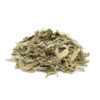Description
It is a very drying herb and helps to dry any excess secretions. This makes is valuable in drying up unwanted breast milk and seeping eruptions.
Traditionally it was used for:
- Sore throats/cough relief
- Digestive aid
- Diarrhoea
- Swelling
- Gum and mouth disease
- Promotes healing
- Relieves bruising, cuts and scrapes
- Cold remedy
- Anti-perspirant
- Memory booster
- Increases bile flow/liver detoxifier
The prime biologically active component of common sage appears to be its essential oil, which chiefly contain ketones; a-thujone, and ß-thujone.
In addition, sage leaf contains numerous other compounds, including cineol, borneol, tannic acid; bitter substances like cornsole and cornsolic acid; fumaric, chlorogenic, caffeic and nicotinic acids; nicotinamide; flavones; flavone glycosides and estrogenic substances.
Altogether, these compounds known to have counter-irritant (reddening), rubefacient (heat producing), anti-inflammatory, anti-allergic, anti-fungal and anti-septic properties.



